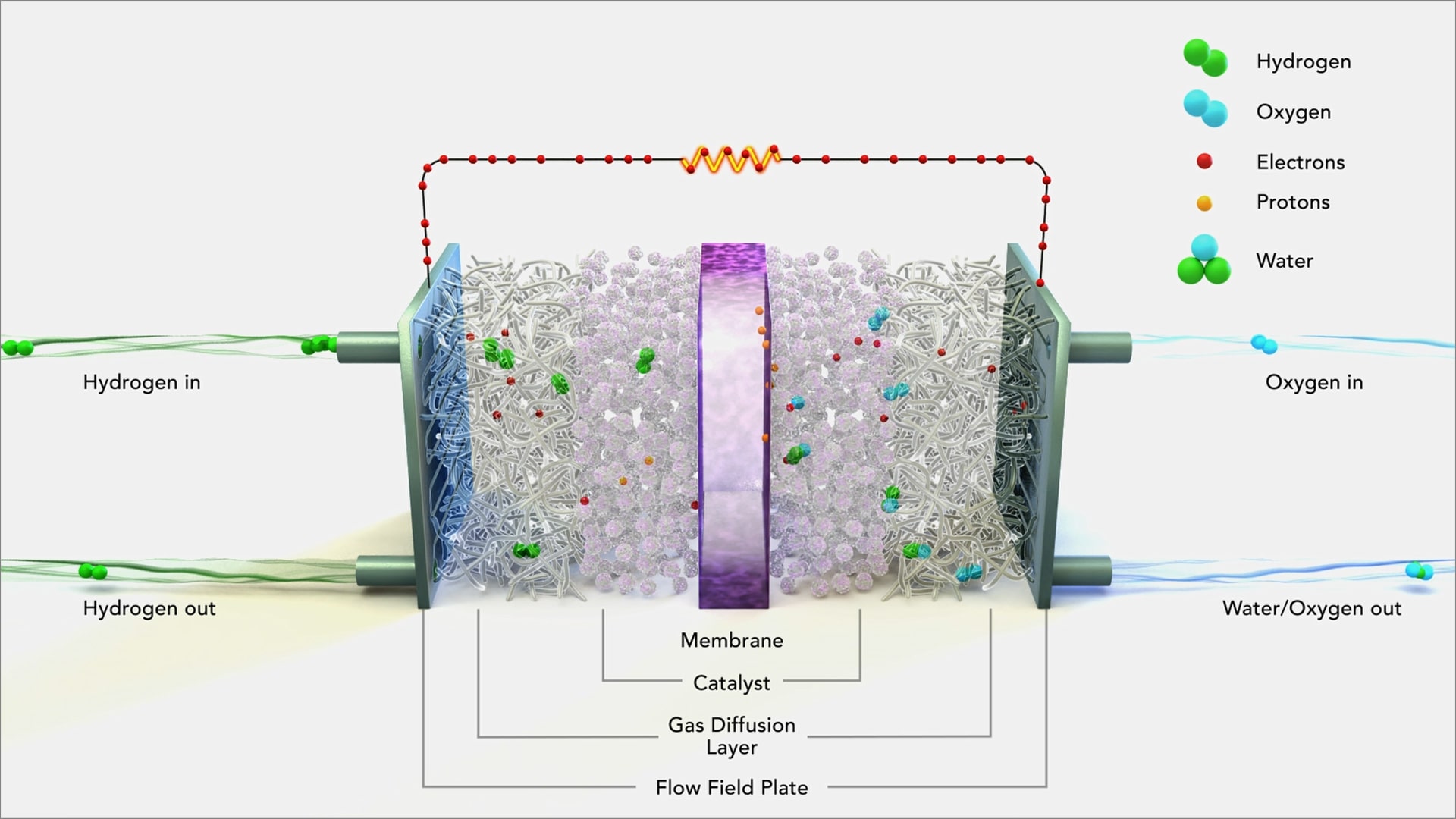
Proton Exchange Membrane Fuel Cell (PEM)
The PEM Fuel Cell generates electricity from hydrogen and oxygen through a chemical reaction. It is considered a zero-emission technology since the only byproducts are water and heat. Due to its high power density, low running temperatures and pressures and quick start-up time the PEM Fuel Cell is an ideal solution for on- and off-highway applications.

Phosphoric Acid Fuel Cell (PAFC)
Phosphoric Acid Fuel Cells (PAFC) utilize liquid phosphoric acid as an electrolyte to produce electricity from hydrogen, offering robust performance and long operational life. Although bulkier and less power-dense than PEM fuel cells, PAFCs are well-suited for larger mobile machinery and stationary power applications due to their higher tolerance to fuel impurities and reliable efficiency.

Solid Oxide Fuel Cell (SOFC)
Solid Oxide Fuel Cells (SOFC) operate at high temperatures using a ceramic electrolyte to convert a variety of fuels into electricity with high efficiency and fuel flexibility. Their suitability for electric trucks, buses, and mobile machinery lies in their potential for high electrical efficiency and the ability to utilize alternative fuels like natural gas, although their long startup times and thermal management needs pose practical challenges for on-the-go applications.
Hydrogen Fuel Cell System
A hydrogen fuel cell system consists of several components, including the fuel cell stack, hydrogen storage, and a power control unit, all working together to provide a continuous and clean energy supply. Widely used in various applications such as electric vehicles and stationary power generation, hydrogen fuel cell systems offer a sustainable and efficient alternative to conventional fossil fuel technologies.


Performance
EFFICIENCY
The performance of hydrogen fuel cells, crucial for zero emission vehicles and renewable energy systems, significantly depends on the purity of hydrogen, the quality of air and the thermal management of the fuel cell system. Contaminants can degrade catalysts and membranes, reducing efficiency. Utilizing high-quality hydrogen fittings, cathode air filters and fuel cell humidifiers is crucial for optimal operation and longevity.

Durability
EFFICIENCY
Durability in hydrogen fuel cells relies on advanced materials and engineering, including the use of hydrogen compatible seals and advanced cooling systems, to withstand operational stresses and prevent degradation. Regular maintenance, thermal management, and minimizing catalyst poisoning are essential for prolonging their operational life and ensuring consistent, efficient energy output.

Leak Rate
SAFETY
Leaks in fuel cells can result from seal deterioration, material fatigue, or improper assembly. Preventative measures include regular maintenance checks, using high-quality materials and components, ensuring precise assembly, and adopting advanced sealing technologies, such as hydrogen seals and hydrogen fittings, to maintain system integrity and safety.

Embrittlement
SAFETY
Hydrogen embrittlement in fuel cells can lead to material degradation and structural failure. Mitigating this involves using hydrogen-resistant alloys and employing proper design and preventive maintenance strategies to ensure the longevity and safety of fuel cell systems.
Fuel Cell Components

Humidifier for Hydrogen Fuel Cells

Hydrogen Filter for Hydrogen Fuel Cells

Seals for Bipolar Plates

Tolerance Compensation Seals (Warp Seals)

Fuel Cell Stack Cooler

High-Pressure Hydrogen Hose Assemblies

O-Lok Fittings

Pressure Sensor
Warp Seals: Sealing of auxiliary units and components of a fuel cell system
Discover how Parker's innovative warp seals revolutionized hydrogen fuel cell systems, delivering reliable sealing performance for auxiliary units with large tolerances. This collaboration led to significant cost savings, reduced assembly efforts, and enhanced production line automation, all without compromising safety.

Useful Resources

Insights into Hydrogen Fuel Systems on Trucks & Buses
WEBINAR
Unlock the potential of hydrogen fuel cell systems and explore their pivotal role in sustainable transportation. Gain insights into the advantages of hydrogen over electric alternatives, understand the mechanics and environmental impacts of hydrogen ICE versus FCEVs, and discover essential components for safe and efficient hydrogen distribution.

How to Maximize Your Fuel Cell’s Performance and Durability
ARTICLE
Optimizing fuel cell performance is crucial for advancing hydrogen technologies. Discover how fuel cells contribute to carbon neutrality and gain actionable insights on enhancing efficiency and longevity. Explore practical tips and Parker’s innovative solutions to drive your projects forward.

Hydrogen Fuel Systems Create Unique Concerns
WHITEPAPER
Discover how to overcome the unique challenges of hydrogen fuel systems. This essential guide provides practical tips for minimizing leaks, safe handling practices, and insights into the latest advancements making hydrogen a viable option today.
